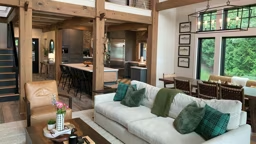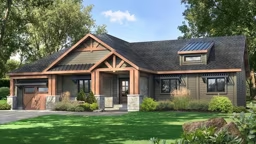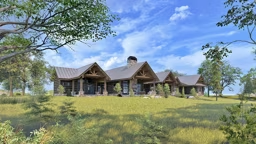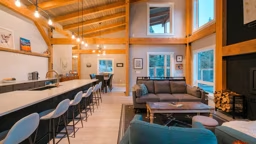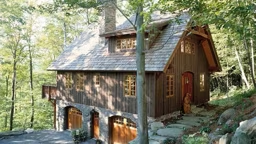
Photo: Yankee Barn Homes, Courtesy of Northpeak Design
We all strive for it — that perfect blend of coziness and elbow room. So what does the “cozy” concept mean to you? Is it a steaming mug of coffee savored from a tiny porch on a brisk morning? Is it enjoying a good book in front of a crackling fire in an expansive great room? Maybe it’s the comfort found in having a sense of order and efficiency in your home. Only you can decide how much house will be the perfect amount.
The concept of a cozy environment may be relative, but proper scale is essential to create comfort. Oversized, open spaces can be overwhelming and stressful just as much as a cramped space can feel claustrophobic.
Once you pin down the square footage that fits, there are a lot of fantastic ways to make it feel like home. We’ve assembled eight of our favorite ideas to keep in mind while you peruse floor plans.
1. Keep the Hearth at the Heart.
Open floor plans are a great use of space, but to keep them warm and welcoming, nothing beats a central hearth. Fireplaces are a log and timber home staple. Not only do they add instant ambiance, they’re they an excellent source of supplemental heat. Just be sure your firebox and ventilation are in good working order.
2. Vary Your Ceiling Heights.
Log and timber home floor plans can feel quite dramatic, and soaring ceilings are often part of the appeal. But when you’re trying to create a cozy cottage, that grandeur may seem a little much. Lowering the ceiling — at least in some areas — is an easy solution. One good candidate is the kitchen, especially since vaulted ceilings can make it difficult to install cabinetry, lighting and vents. Single-story bedrooms are smart, too, because what should be cozier than the spot where you sleep?
3. Make Your Entryway Welcoming.
It’s the first thing guests see when they walk through the front door, and while a soaring two-story foyer is dramatic, it also can feel overpowering in a log cabin or timber cottage. Create a bit of suspense and allow your home to unfold slowly by looking to floor plans that feature a distinct, small-scale foyer.
4. Allow Your Home to Tell a Story.
The natural warmth of exposed logs and timbers automatically imparts a cozy feeling to a house, but you can take that ambiance a step further by incorporating reclaimed materials in the mix. It could be as decorative as adding vintage doors or antique hardwood flooring, or you could source timbers from old railroad trestles and repurpose them in a more structural way. Whatever you choose, learn the provenance of the pieces so you can share their story with guests when they ask (and they will).
5. Let the Light Shine.
Sunshine is nature’s little pick-me-up, so infusing your home with natural light will make a small space feel bright and cheery. It’s especially important to consider this fact if your home has a walk-out basement, where you’ll want to introduce as much sunlight as possible. If it’s feasible, opt for 9-foot ceilings in the lower level, which should allow for oversized 8-foot-tall windows. This extra height can make a huge difference in the livability and enjoyment of your home.
6. Establish a Light Mood.
The sun may be the ideal light source, but once it sets, it’s vital to have properly layered illumination in a log or timber home. Ambient (general) light can come from above in the form of inconspicuous recessed lights or a dramatic chandelier. Dimmer switches will let you adjust the level of light to create a specific mood. Both ambient and directed task light are essential in the kitchen for safety, and accent lighting (sconces, spotlights or even colored LEDs) add the drama.
7. Create Nooks and Crannies.
After you establish the overall layout of your house, identify places where you could add a nook for a breakfast table, a reading chair or game area. Special spaces like these not only carve out spots for relaxation or casual entertaining, they take a small home’s design from adequate to exceptional. Where do you find them? Look for what design experts call “dead-end” spaces, like the end of a hallway or a corner of a great room. Then define these spaces by infusing them with architectural details that set them apart.
8. Keep it Small … But Not Too Small.
The “tiny home” concept seems to have had its day. While the desire for smaller homes continues, buyers have realized that they have to be realistic in terms of size — especially in a full-time residence — and if a home is too small, it will feel cramped, not cozy. While reviewing small-scale floor plans, take care to ensure the spaces are livable. Look for ways you can devote space for items like an office, media room or home library. Personalized spaces like these are what convert a plan from a house to a home.





